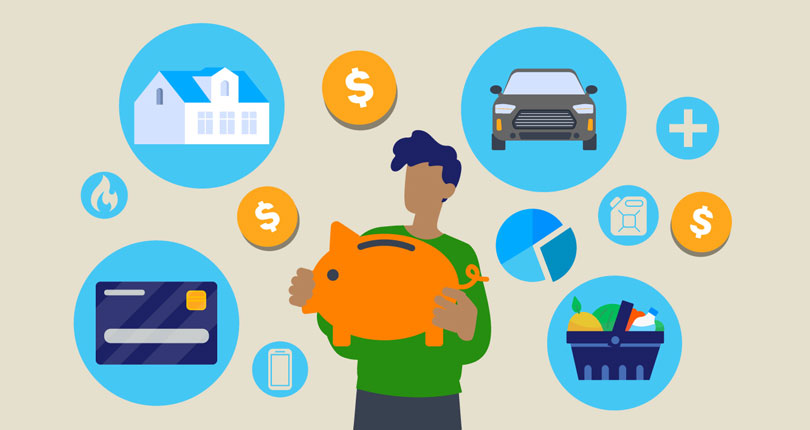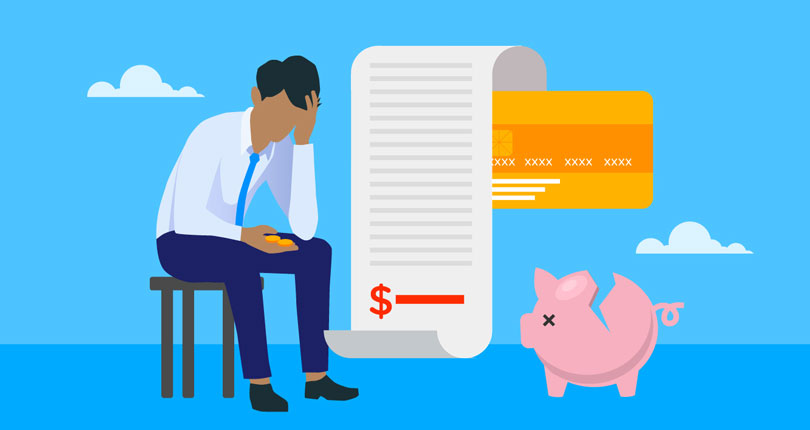How Dirty Are Cash, Cards and Contactless Pay Options?
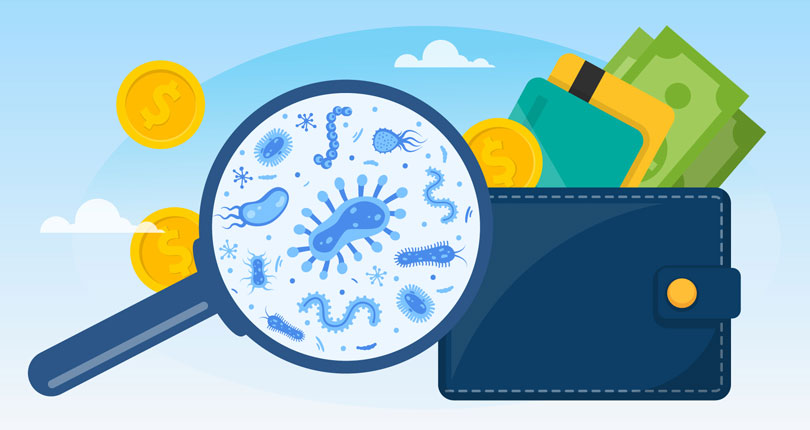
Coronavirus heightened everyone’s awareness of germ transmission – with many stores introducing a contactless-only payment system during the pandemic. But does contactless payment really mean less contact with germs?
CDC guidelines recommend washing your hands after most interactions that could contain germs. [1] Centers for Disease Control and Prevention, ‘When and How to Wash Your Hands’ https://www.cdc.gov/handwashing/when-how-handwashing.html However, this frequency greatly depends on where you are and what you do – and if you’re going out shopping you might want to notch this number up quite a bit.
Researchers on behalf of Self Financial used a hygiene monitoring tool, certified by the Association of Official Analytical Chemists (AOAC), to measure germ levels on popular payment options: coins, dollar bills, debit and credit cards, phones and a smartwatch.
But how does the science behind the tool work? The more technical term for ‘germ level’ is ATP – an indicator for the volume of organisms and microbes on a surface. The higher the ATP level, the grimier the object is likely to be, and the grimier it is, the more likely there are some nasty pathogens on there to make you sick. For the nitty-gritty details on how this technology works see the methodology at the bottom of the page.
Key findings
- Smartwatches are dirtier than your phone, cards or cash – with a germ level of 902, three times above the national institute cleanliness maximum of 250.
- Cell phones are 146% dirtier than the minimum hygiene standard of 250.
- Although still failing the minimum standard of cleanliness, the average card is 38.4% cleaner than your phone.
- The only dollar bill to pass the minimum standard of cleanliness was the $50 bill.
- Only cent coins met minimum cleanliness standards (with an average germ level of 168).
Smartwatches are three times dirtier than international hygiene standards
Unless you are diligent about its removal, the watch on your wrist will become contaminated while you use the toilet, when you’re cooking at home, and as you shake hands or open doors. Now, with the invention of smartwatches, that same watch on your wrist while using the bathroom is paying for your groceries.
Smartwatches were found to have a germ level of 902, the worst score in the study and three times above the international hygiene limit of 250. In fact, the data suggests that pressing your smartwatch against a contactless machine is spreading 437% more bacteria than handing coins over from your wallet.
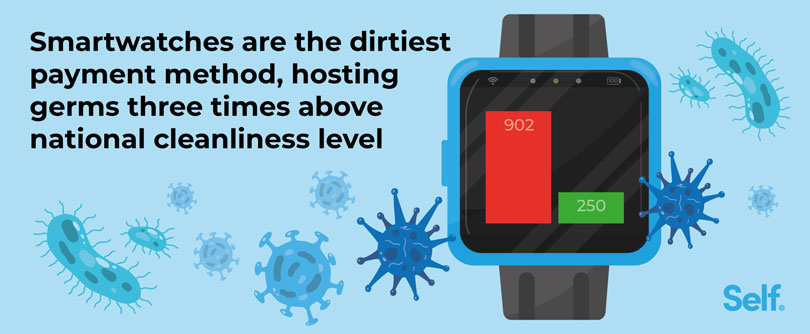
Phones are 146% dirtier than the minimum hygiene standard
The average American now spends 4 hours 25 minutes per day on their phone. [2] Fortune, ‘Americans check their phones 144 times a day. Here’s how to cut back’ ’ https://fortune.com/well/2023/07/19/how-to-cut-back-screen-time/ All this tapping and swiping throughout the day encourages the transmission of bacteria from your fingertips to the screen.
The cell phones in the study had a germ level of 615, the 2nd highest in the study – that’s 146% dirtier than the maximum acceptable germ level of 250.
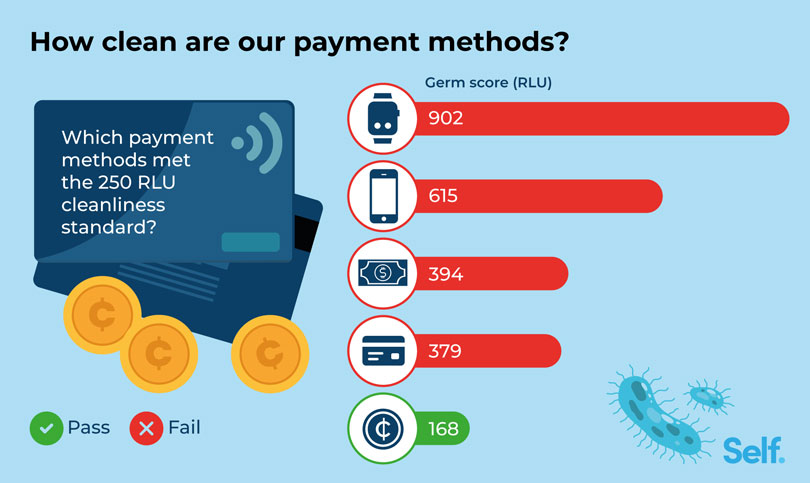
The most used credit cards are the dirtiest
Although the overall average germ score of a debit or credit card was discovered to be 379 – making this payment method the 2nd cleanest in the study – the ATP levels varied wildly between the samples. One card registered as 112 (certifiably ‘clean’ ) and the worst card scored 691 – dirtier than the average phone. Researchers found this tended to follow a pattern: the most used credit cards for payments were the ones that had higher germ scores.
The $10 bill is the dirtiest
The dirtiest bill in the study was the $10 bill, 164.4% dirtier than the 250 germ score threshold and 71.7% dirtier than the next grubbiest buck – the humble $1 dollar bill. The $1 dollar bill is the second most circulated bill in America, so perhaps it’s no surprise that this bill is up there on the ranking. [3] International Monetary Fund, ‘What makes the US$100 bill so popular?’ https://www.imf.org/en/Publications/fandd/issues/2019/06/what-makes-the-US-100-bill-so-popular-currency
Bigger bills live longer lives, the average lifespan of a $100 dollar bill is 22.9 years. [4] Federal Reserve, ‘How long is the lifespan of U.S. paper money?’ https://www.federalreserve.gov/faqs/how-long-is-the-life-span-of-us-paper-money.htm This is because they are handled less frequently – perhaps why the $100 and $50 dollar bills were the cleanest in the study.
Only one of the bills and three of the cents met minimum hygiene standards, the cleanest of these being the tiny one cent.
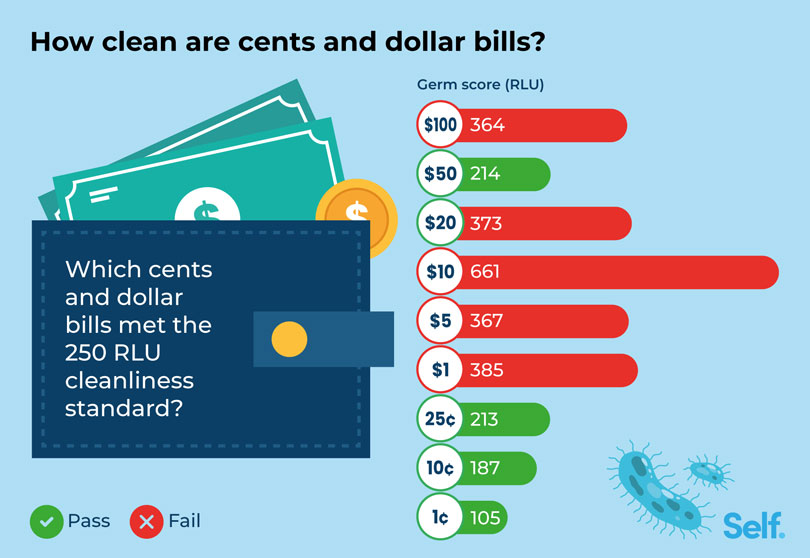
Hygiene tips to keep your money clean
Just because the coronavirus pandemic is now under control, doesn’t mean people should fall back into bad habits. To keep yourself and others safe when shopping, there are some things you can do to keep your coins, bills and hardware clean:
- The elementary advice by the CDC (Centers for Disease Control and Prevention) is to use online services where you can, use hand sanitizer after completing a purchase and wash your hands for at least 20 seconds when arriving back home. [5] Centers for Disease Control and Prevention, ‘Running Essential Errands’ https://stacks.cdc.gov/view/cdc/88371/cdc_88371_DS1.pdf
- Keep your purse or wallet clean: Consider buying a wallet that is easy to wipe down and disinfect, and set time aside to clean it and your cards thoroughly weekly.
- Use separate compartments for clean and used money: store clean and used bills in your wallet in separate pockets or compartments.
- Keep your money dry: Not only can water damage your bills or cause them to tear, but damp bills or damp compartments in your wallet create a breeding ground for germs.
- Air out the debris from your phone: don’t risk damage by sticking Q-tips into the crevices of your phone. Compressed air is an efficient way to clean out ports, speakers, and other small crevices in your devices.
Methodology
Researchers on behalf of Self Financial sampled germ levels on various payment options using 3M’s Clean-Trace® Hygiene Monitoring & Management System, which analyzes levels of Adenosine Triphosphate (ATP) on surfaces. Microbiology data was collected in November 2023 and analyzed in December 2023.
All dollars and coins were sampled from active circulation in the U.S. Hardware swabbed and coins were not cleaned before swabbing. These items were analyzed using the Clean-Trace system:
- $1, $5, $10, $20, $50, $100
- 1c, 10c, 25c
- Three debit and credit cards
- iPhone and Samsung S8
- Apple Watch
ATP is an indicator of microorganisms, biofilm and other biological residues which aren’t visible to the naked eye. When something is unclean or dirty, the presence of these organisms and residues increases, meaning that ATP is an effective indicator of cleanliness and hygiene.
The tool used, 3M’s Clean-Trace® Hygiene Monitoring & Management System, measures ATP in RLU (relative light units). This is achieved using a process called bioluminescence – where the test reacts with oxygen and the light-emitting pigment luciferin. Therefore, the amount of light emitted (RLU) is directly proportional to the amount of ATP on the surface.
According to the National Institutes of Health, the following scale should be used when measuring relative light levels on surfaces.
| Cleanliness classification | RLU levels on measurement |
|---|---|
| Very clean | Both < 100 RLU |
| Clean | Both < 250 RLU |
| Equivocal | One < 250 RLU + One > 250 RLU |
| Dirty/Fail | Both > 250 RLU |
For more information and to find out more about the tool and how it works see here.
Sources
- [1] Centers for Disease Control and Prevention, ‘When and How to Wash Your Hands’ https://www.cdc.gov/handwashing/when-how-handwashing.html
- [2] Fortune, ‘Americans check their phones 144 times a day. Here’s how to cut back’ ’ https://fortune.com/well/2023/07/19/how-to-cut-back-screen-time/
- [3] International Monetary Fund, ‘What makes the US$100 bill so popular?’ https://www.imf.org/en/Publications/fandd/issues/2019/06/what-makes-the-US-100-bill-so-popular-currency
- [4] Federal Reserve, ‘How long is the lifespan of U.S. paper money?’ https://www.federalreserve.gov/faqs/how-long-is-the-life-span-of-us-paper-money.htm
- [5] Centers for Disease Control and Prevention, ‘Running Essential Errands’ https://stacks.cdc.gov/view/cdc/88371/cdc_88371_DS1.pdf


